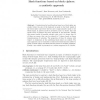Free Online Productivity Tools
i2Speak
i2Symbol
i2OCR
iTex2Img
iWeb2Print
iWeb2Shot
i2Type
iPdf2Split
iPdf2Merge
i2Bopomofo
i2Arabic
i2Style
i2Image
i2PDF
iLatex2Rtf
Sci2ools
CRYPTO
1993
Springer
1993
Springer
Hash Functions Based on Block Ciphers: A Synthetic Approach
Constructions for hash functions based on a block cipher are studied where the size of the hashcode is equal to the block length of the block cipher and where the key size is approximately equal to the block length. A general model is presented, and it is shown that this model covers 9 schemes that have appeared in the literature. Within this general model 64 possible schemes exist, and it is shown that 12 of these are secure; they can be reduced to 2 classes based on linear transformations of variables. The properties of these 12 schemes with respect to weaknesses of the underlying block cipher are studied. The same approach can be extended to study keyed hash functions (MAC’s) based on block ciphers and hash functions based on modular arithmetic. Finally a new attack is presented on a scheme suggested by R. Merkle.
| Added | 09 Aug 2010 |
| Updated | 09 Aug 2010 |
| Type | Conference |
| Year | 1993 |
| Where | CRYPTO |
| Authors | Bart Preneel, René Govaerts, Joos Vandewalle |
Comments (0)

